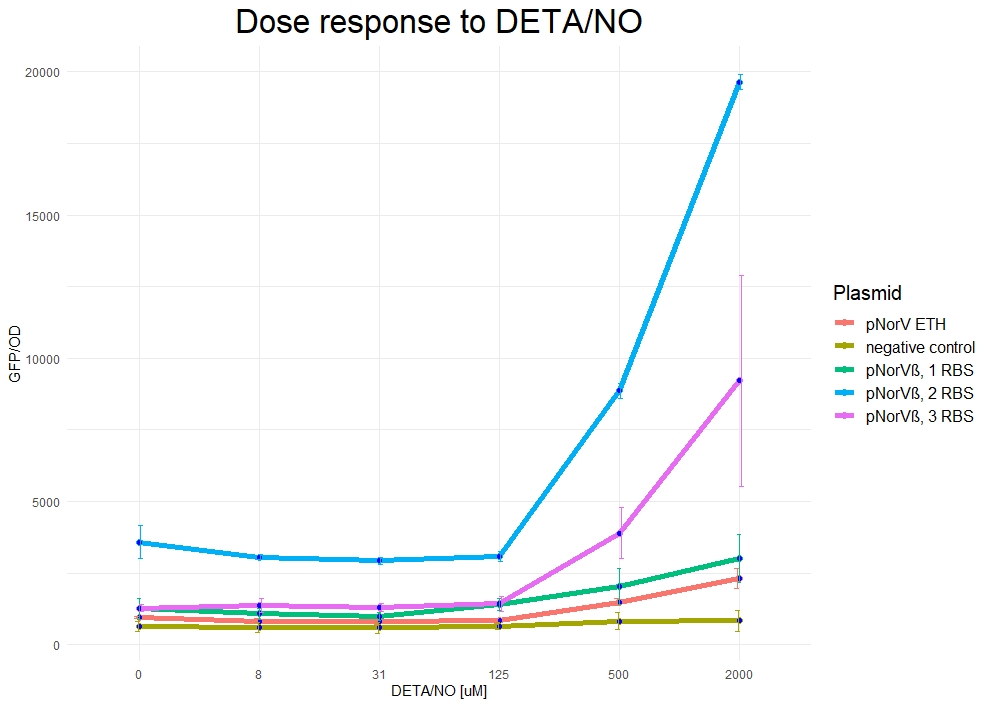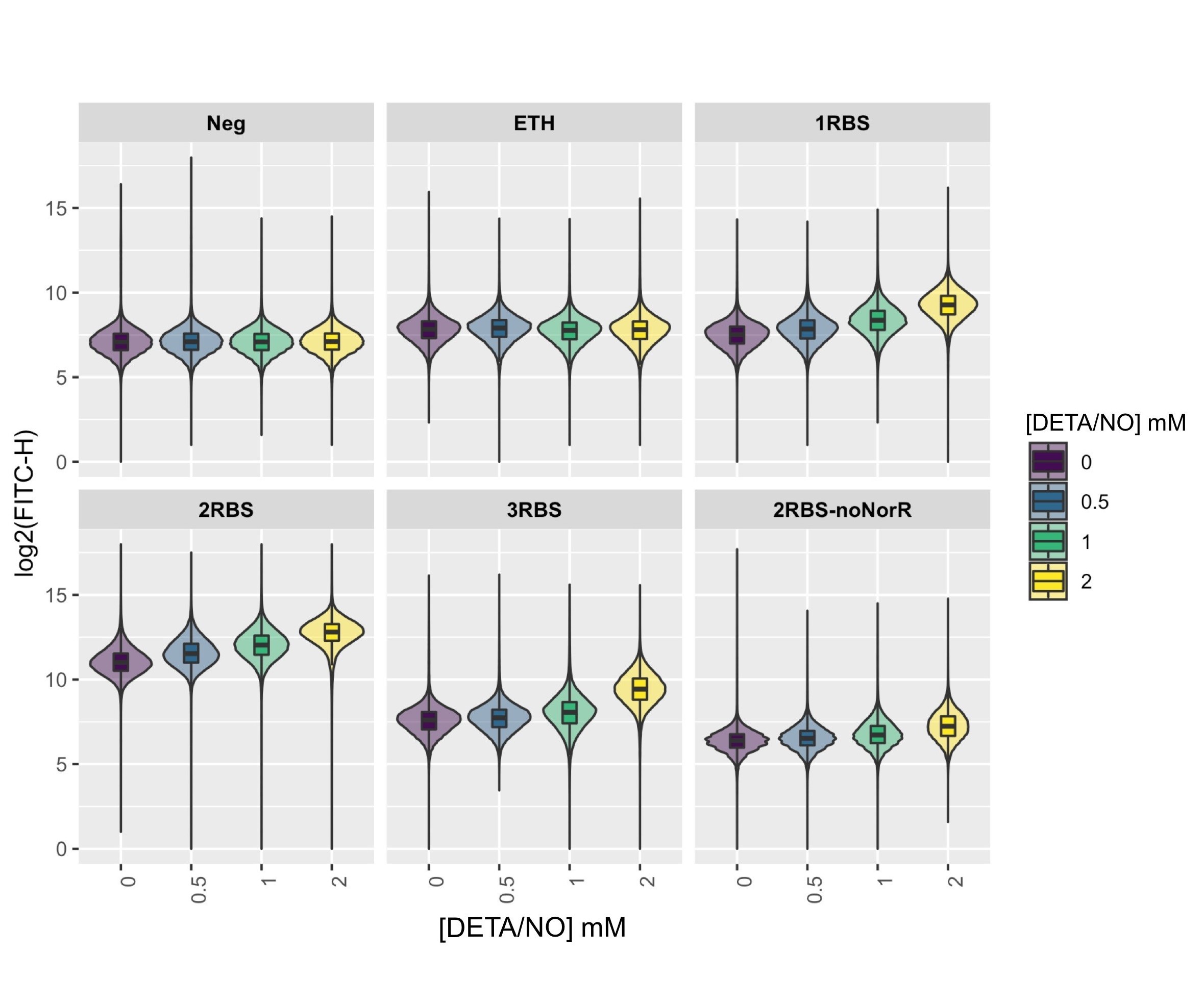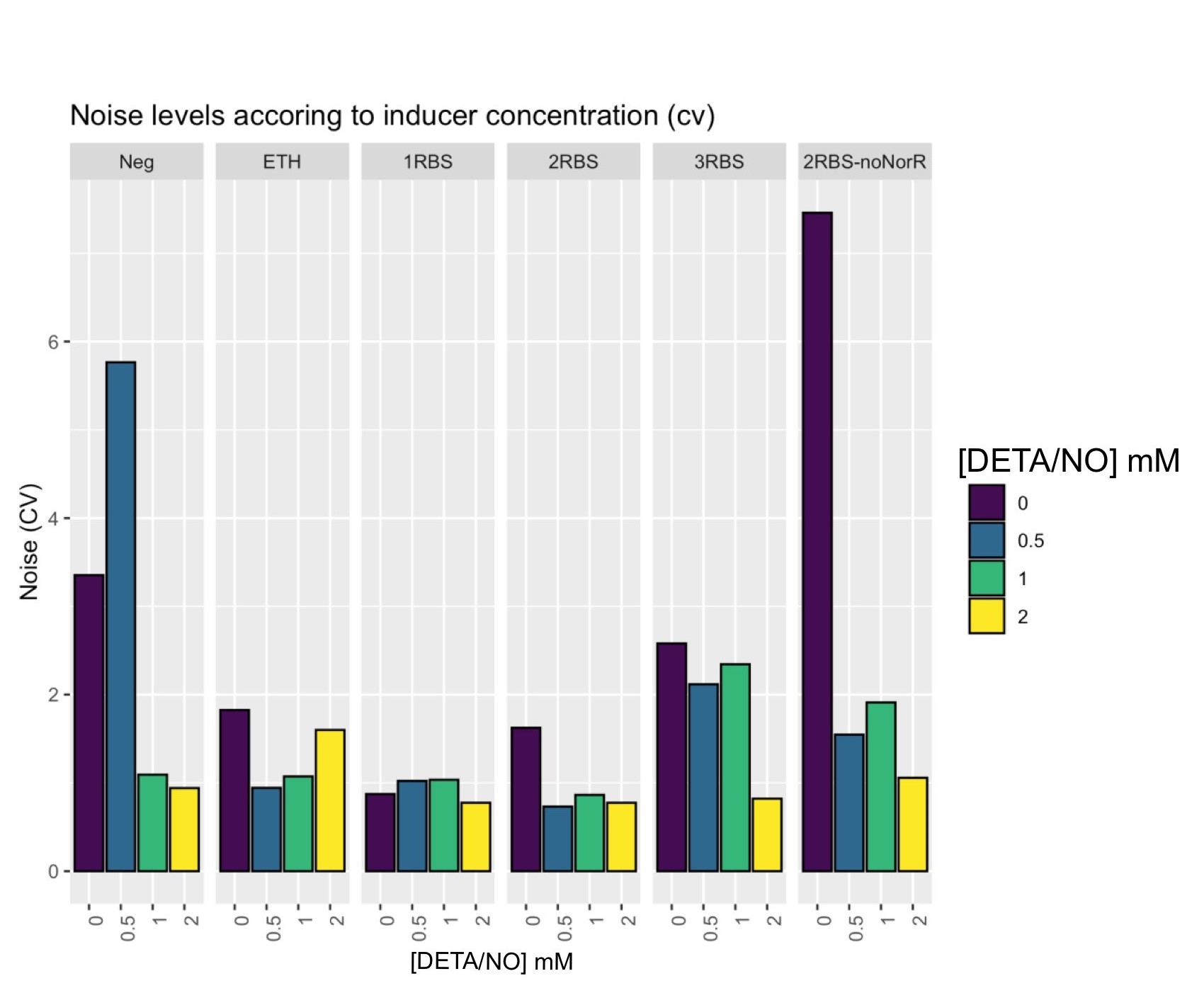Part:BBa_K4387000
Nitric Oxide Sensing Promoter pNorVβ
Contents
- 1 Usage and Biology
- 2 Sequence and Features
- 3 Characterization and Measurements
- 3.1 Nitric Oxide Sensing Genetic Circuit With One Ribosomal Binding Site
- 3.2 Nitric Oxide Sensing Genetic Circuit With Two Ribosomal Binding Sites
- 3.3 Nitric Oxide Sensing Genetic Circuit With Three Ribosomal Binding Sites
- 3.4 Nitric Oxide Sensing Genetic Circuit Without the NorR regulator
- 3.5 Exchanging the sfGFP with a Single Domain Antibody
- 4 References
Usage and Biology
The inducible pNorVβ is an optimized nitric oxide sensitive promoter regulated by NorR. The corresponding integration host factor IHF2 binding site was removed from the promoter pNorV to exhibit good sensitivity and dosage response at a low range of inducer DETA/NO, the used nitric oxide source in our experiments, activating the downstream genes' transcription [1]. In our constructs below, this promoter was coupled to a superfolder GFP and the transcriptional regulator NorR BBa_K4387001 which creates a feedback loop to finetune the amount of NorR to the number of free NO molecules. It is also an improved part of the 2016 ETH iGEM team pNorV promoter.
This promoter was tested in the bacterial strain E.coli Nissle 1917.
Sequence and Features
- 10COMPATIBLE WITH RFC[10]
- 12COMPATIBLE WITH RFC[12]
- 21COMPATIBLE WITH RFC[21]
- 23COMPATIBLE WITH RFC[23]
- 25COMPATIBLE WITH RFC[25]
- 1000COMPATIBLE WITH RFC[1000]
Characterization and Measurements
Measuring parts with different approaches and comparing them to provide a more insightful and multilayered characterization is essential in Synthetic Biology. Here, we focused on two methods:
(i) time-lapse plate reader assays to measure the sensitivity of our circuit to NorR in a dynamic manner and under different concentrations of inducer; and
(ii) endpoint flow cytometry assays to measure the behavior of our circuits at the single-cell scale.
With the first assay, we uncovered essential kinetic information about the circuits on the populational level (every measurement is an average of the individual expression patterns in the sample). With the second assay, we delved deeper into the cell populations to characterize other essential properties of our system, such as expression noise and dose-dependent responses to different inducer concentrations.
To make our experiments reproducible during plate reader assays (PHERAstar FSX - λEx: 485 nm, λEm: 530 nm), we measured each sample for 16 hours at 37°C and constant orbital shaking, using three biological replicates (three individual colonies per circuit) and three technical replicates (three wells per biological replicate).
We performed the data analysis as follows:
- Subtracted blanks from raw data
- Normalize GFP by OD600
- Calculate technical means of GFP/OD600 normalized data
- Calculate the biological means of GFP/OD600 normalized data
- Calculate the biological standard deviation of GFP/OD600 normalized data
- When necessary, perform imputation. Usually, the first normalized measurements are noisy and unreliable as OD600 values can be very low and significantly impact normalization. Thus, when individual normalized values are extremely high or low (sometimes negative due to blank correction), imputation was used following a na_kalman() function from the ImputeTS R package.
- Additional transformations, such as log transformations.
Hence, our plots show the averages and standard deviations for the biological replicates for each sample for each time point.
For the flow cytometry experiment, cell cultures were grown overnight in LB medium supplemented with antibiotic, diluted in 2mL of M9 (supplemented with glucose, cas amino acids and an antibiotic) in a 1:10 ratio (v/v), induced with different NO concentrations and grown for 7 hours in a shaker (37C, 220 RPM). Samples were then chilled on ice to halt cell growth and diluted in 1mL of cold PBS (1:500 v/v ratio). A total of 100,000 cells per sample was measured in a BD FACSCanto II flow cytometer (FSC: 625V, SSC: 420V, FITC: 650V, Event threshold: FSC & SSC > 200, Channel: FITC (λEx 488 nm / λEm. 530/30 nm, High flow rate: ~ 10,000 events/s).
We performed all analyses using in-house R scripts.
Nitric Oxide Sensing Genetic Circuit With One Ribosomal Binding Site
This part consists of the inducible pNorVβ promoter, a superfolder GFP preceded by one strong ribosomal binding site (BBa_B0034), the NorR regulator, and a double forward terminator. We chose a high-copy backbone from Twist Bioscience for this part. Due to the competitive binding of the activated and inactivated NorR on the promoter, we decided on this construct with a positive feedback loop that adjusted the levels of NorR based on the amount of nitric oxide present [1]. The presence of nitric oxide would activate pNorVβ to induce GFP and NorR expression. Thereby, we ensure that high amounts of NorR will be produced only when NO is present.
Time-Lapse Plate Reader Assay

To make our experiments reproducible during plate reader assays (PHERAstar FSX - λEx: 485 nm, λEm: 530 nm), we measured each sample for 16 hours at 37°C and constant orbital shaking, using three biological replicates (three individual colonies per circuit) and three technical replicates (three wells per biological replicate).
We performed the data analysis as follows:
- Subtracted blanks from raw data
- Normalize GFP by OD600
- Calculate technical means of GFP/OD600 normalized data
- Calculate the biological means of GFP/OD600 normalized data
- Calculate the biological standard deviation of GFP/OD600 normalized data
- When necessary, perform imputation. Usually, the first normalized measurements are noisy and unreliable as OD600 values can be very low and significantly impact normalization. Thus, when individual normalized values are extremely high or low (sometimes negative due to blank correction), imputation was used following a na_kalman() function from the ImputeTS R package.
- Additional transformations, such as log transformations.
Hence, our plots show the averages and standard deviations for the biological replicates for each sample for each time point.
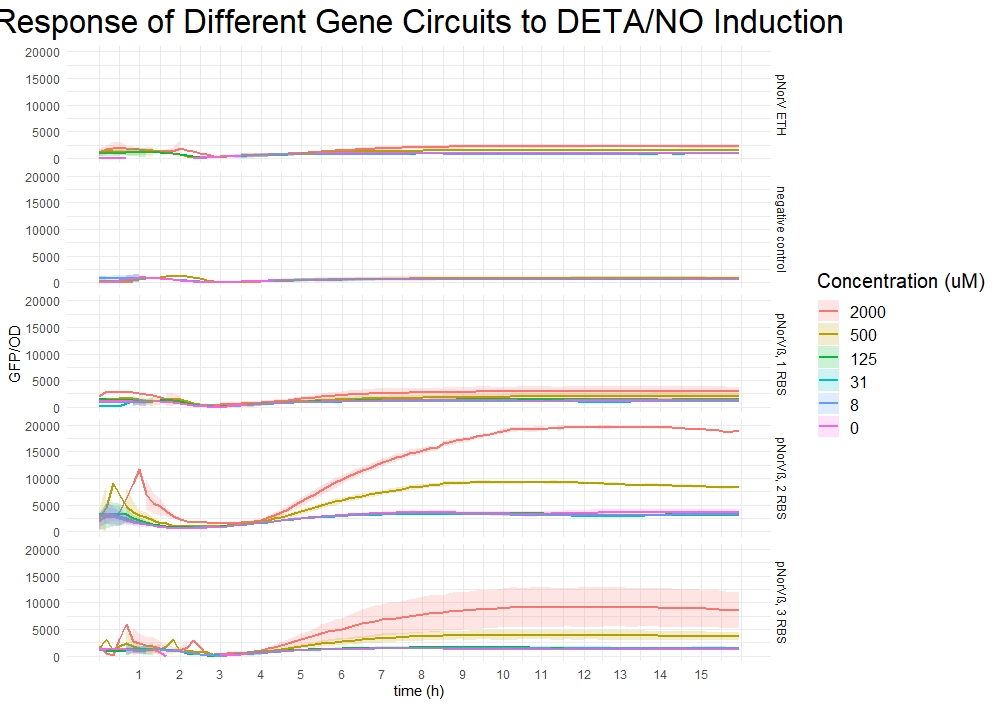
Because the standard deviations overlap, we thought that we might be able to reduce the standard deviations and get a clearer result if we had more samples. To get more samples, we also performed a flow cytometer.
Endpoint Flow Cytometry Assay
For the flow cytometry experiment, cell cultures were grown overnight in LB medium supplemented with antibiotic, diluted in 2mL of M9 (supplemented with glucose, cas amino acids, and an antibiotic) in a 1:10 ratio (v/v), induced with different NO concentrations and grown for 7 hours in a shaker (37C, 220 RPM). Samples were then chilled on ice to halt cell growth and diluted in 1mL of cold PBS (1:500 v/v ratio). A total of 100,000 cells per sample was measured in a BD FACSCanto II flow cytometer (FSC: 625V, SSC: 420V, FITC: 650V, Event threshold: FSC & SSC > 200, Channel: FITC (λEx 488 nm / λEm. 530/30 nm, High flow rate: ~ 10,000 events/s).
While figure 4a shows that the construct with pNorVβ and 2 RBS (BBa_K4387006) has higher overall GFP expression values, it is also leakier than this construct with pNorVβ and 1 RBS (BBa_K4387005) or the construct with pNorVβ and 3 RBS (BBa_K4387007). If high GFP expression is required, but some leakiness does not matter much, we recommend choosing BBa_K4387006. If lower leakiness is essential, but GFP expression does not need to be very high, we recommend using parts BBa_K4387005 or BBa_K4387007 instead.
Nitric Oxide Sensing Genetic Circuit With Two Ribosomal Binding Sites
In the frame of our project, we wanted to improve the construct BBa_K4387005 by adding one more ribosomal binding site to see if we could achieve a higher GFP response.
Thus this part consists of the inducible pNorVβ promoter, a superfolder GFP preceded by two strong ribosomal binding sites (BBa_B0029, BBa_B0034), the (NorR regulator), and a double forward terminator. We chose a high-copy backbone from Twist Bioscience for this part. Due to the competitive binding of the activated and inactivated NorR on the promoter, we decided on this construct with a positive feedback loop that adjusted the levels of NorR based on the amount of nitric oxide present [1]. The presence of nitric oxide would activate pNorVβ to induce GFP and NorR expression. Thereby, we ensure that high amounts of NorR will be produced only when NO is present.
Time-Lapse Plate Reader Assay
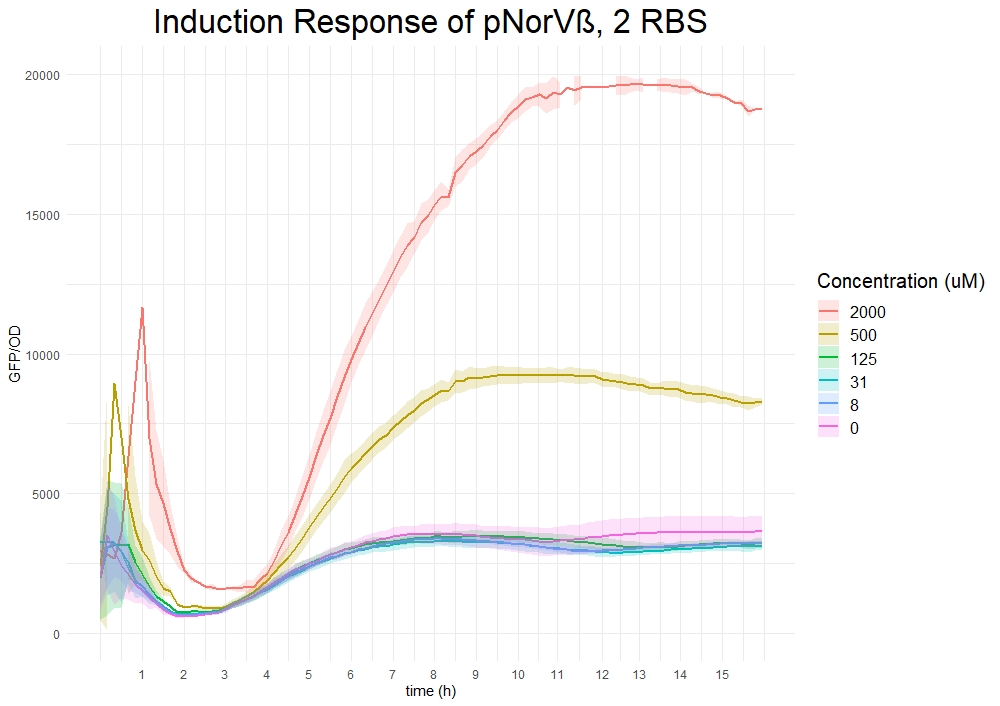
To make our experiments reproducible, during plate reader assays (PHERAstar FSX - λEx: 485 nm, λEm: 530 nm), we measured each sample for 16 hours at 37°C and constant orbital shaking, using three biological replicates (three individual colonies per circuit) and three technical replicates (three wells per biological replicate).
We performed the data analysis as follows:
- Subtracted blanks from raw data
- Normalize GFP by OD600
- Calculate technical means of GFP/OD600 normalized data
- Calculate the biological means of GFP/OD600 normalized data
- Calculate the biological standard deviation of GFP/OD600 normalized data
- When necessary, perform imputation. Usually, the first normalized measurements are noisy and unreliable as OD600 values can be very low and significantly impact normalization. Thus, when individual normalized values are extremely high or low (sometimes negative due to blank correction), imputation was used following a na_kalman() function from the ImputeTS R package.
- Additional transformations, such as log transformations.
Hence, our plots show the averages and standard deviations for the biological replicates for each sample for each time point.

Because the standard deviations overlap, we thought that we might be able to reduce the standard deviations and get a clearer result if we had more samples. To get more samples, we also performed a flow cytometry.
Endpoint Flow Cytometry Assay
For the flow cytometry experiment, cell cultures were grown overnight in LB medium supplemented with antibiotic, diluted in 2mL of M9 (supplemented with glucose, cas amino acids, and an antibiotic) in a 1:10 ratio (v/v), induced with different NO concentrations and grown for 7 hours in a shaker (37C, 220 RPM). Samples were then chilled on ice to halt cell growth and diluted in 1mL of cold PBS (1:500 v/v ratio). A total of 100,000 cells per sample was measured in a BD FACSCanto II flow cytometer (FSC: 625V, SSC: 420V, FITC: 650V, Event threshold: FSC & SSC > 200, Channel: FITC (λEx 488 nm / λEm. 530/30 nm, High flow rate: ~ 10,000 events/s).
While figure 6a shows that the construct with pNorVβ and 2 RBS (BBa_K4387006) has higher overall GFP expression values, it is also leakier than the construct with pNorVβ and 1 RBS (BBa_K4387005) or the construct with pNorVβ and 3 RBS (BBa_K4387007). If high GFP expression is required, but some leakiness does not matter much, we recommend choosing BBa_K4387006. If lower leakiness is essential, but GFP expression does not need to be very high, we recommend using parts BBa_K4387005 or BBa_K4387007 instead.
Nitric Oxide Sensing Genetic Circuit With Three Ribosomal Binding Sites
In the frame of our project, we wanted to further improve the construct BBa_K4387005 by adding two more ribosomal binding sites to see if we could achieve a higher GFP response.
Thus this part consists of the inducible pNorVβ promoter, superfolder GFP preceded by three strong ribosomal binding sites (BBa_K4387020 [2], BBa_B0029, BBa_B0034), the NorR regulator, and a double forward terminator. We chose a high-copy backbone from Twist Bioscience for this part. Due to the competitive binding of the activated and inactivated NorR on the promoter, we decided on this construct with a positive feedback loop that adjusted the levels of NorR based on the amount of nitric oxide present [1]. The presence of nitric oxide would activate pNorVβ to induce GFP and NorR expression. Thereby, we ensure that high amounts of NorR will be produced only when NO is present.
Time-Lapse Plate Reader Assay

To make our experiments reproducible during plate reader assays (PHERAstar FSX - λEx: 485 nm, λEm: 530 nm), we measured each sample for 16 hours at 37°C and constant orbital shaking, using three biological replicates (three individual colonies per circuit) and three technical replicates (three wells per biological replicate).
We performed the data analysis as follows:
- Subtracted blanks from raw data
- Normalize GFP by OD600
- Calculate technical means of GFP/OD600 normalized data
- Calculate the biological means of GFP/OD600 normalized data
- Calculate the biological standard deviation of GFP/OD600 normalized data
- When necessary, perform imputation. Usually, the first normalized measurements are noisy and unreliable as OD600 values can be very low and significantly impact normalization. Thus, when individual normalized values are extremely high or low (sometimes negative due to blank correction), imputation was used following a na_kalman() function from the ImputeTS R package.
- Additional transformations, such as log transformations.
Hence, our plots show the averages and standard deviations for the biological replicates for each sample for each time point.

Because the standard deviations overlap, we thought that we might be able to reduce the standard deviations and get a clearer result if we had more samples. To get more samples, we also performed a flow cytometry.
Endpoint Flow Cytometry Assay
For the flow cytometry experiment, cell cultures were grown overnight in LB medium supplemented with antibiotic, diluted in 2mL of M9 (supplemented with glucose, cas amino acids and an antibiotic) in a 1:10 ratio (v/v), induced with different NO concentrations and grown for 7 hours in a shaker (37C, 220 RPM). Samples were then chilled on ice to halt cell growth and diluted in 1mL of cold PBS (1:500 v/v ratio). A total of 100,000 cells per sample was measured in a BD FACSCanto II flow cytometer (FSC: 625V, SSC: 420V, FITC: 650V, Event threshold: FSC & SSC > 200, Channel: FITC (λEx 488 nm / λEm. 530/30 nm, High flow rate: ~ 10,000 events/s).
While figure 8a shows that the construct with pNorVβ and 2 RBS (BBa_K4387006) has higher overall GFP expression values, it is also leakier than the construct with pNorVβ and 1 RBS (BBa_K4387005) or this construct with pNorVβ and 3 RBS (BBa_K4387007). If high GFP expression is required, but some leakiness does not matter much, we recommend choosing BBa_K4387006. If lower leakiness is essential, but GFP expression does not need to be very high, we recommend using parts BBa_K4387005 or BBa_K4387007 instead.
Nitric Oxide Sensing Genetic Circuit Without the NorR regulator
In the frame of our project, we wanted to improve the sensitivity of our construct BBa_K4387005. For this purpose, we removed the codon-optimized NorR, creating a circuit that would rely on endogenous NorR.
Thus this part consists of the inducible pNorVβ promoter, superfolder GFP preceded by two strong ribosomal binding sites (BBa_B0029, BBa_B0034), and a double forward terminator. We chose a high-copy backbone from Twist Bioscience for this part.
Time-Lapse Plate Reader Assay

To make our experiments reproducible during plate reader assays (PHERAstar FSX - λEx: 485 nm, λEm: 530 nm), we measured each sample for 16 hours at 37°C and constant orbital shaking, using three biological replicates (three individual colonies per circuit) and three technical replicates (three wells per biological replicate).
We performed the data analysis as follows:
- Subtracted blanks from raw data
- Normalize GFP by OD600
- Calculate technical means of GFP/OD600 normalized data
- Calculate the biological means of GFP/OD600 normalized data
- Calculate the biological standard deviation of GFP/OD600 normalized data
- When necessary, perform imputation. Usually, the first normalized measurements are noisy and unreliable as OD600 values can be very low and significantly impact normalization. Thus, when individual normalized values are extremely high or low (sometimes negative due to blank correction), imputation was used following a na_kalman() function from the ImputeTS R package.
- Additional transformations, such as log transformations.
Hence, our plot shows the averages and standard deviations for the biological replicates for each sample for each time point.
According to figure 9, removing the codon-optimized transcriptional regulator NorR did not improve the NO-sensing range. Instead, it reduced the GFP expression at the same NO concentration as in previous experiments.
Endpoint Flow Cytometry Assay
For the flow cytometry experiment, cell cultures were grown overnight in LB medium supplemented with antibiotic, diluted in 2mL of M9 (supplemented with glucose, cas amino acids, and an antibiotic) in a 1:10 ratio (v/v), induced with different NO concentrations and grown for 7 hours in a shaker (37C, 220 RPM). Samples were then chilled on ice to halt cell growth and diluted in 1mL of cold PBS (1:500 v/v ratio). A total of 100,000 cells per sample was measured in a BD FACSCanto II flow cytometer (FSC: 625V, SSC: 420V, FITC: 650V, Event threshold: FSC & SSC > 200, Channel: FITC (λEx 488 nm / λEm. 530/30 nm, High flow rate: ~ 10,000 events/s).
As shown in the violin plots, the circuit without NorR, although it is not leakier than the other constructs, has a relatively high noise level (figures 10a and 10b). Since its response to the induction with DETA/NO is also decreased compared to its counterpart with the feedback loop, we consider this construct inadequately suited as a nitric oxide sensor (figure 10a).
While figure 10a shows that the construct with pNorVβ and 2 RBS (BBa_K4387006) has higher overall GFP expression values, it is also leakier than the construct with pNorVβ and 1 RBS (BBa_K4387005) or the construct with pNorVβ and 3 RBS (BBa_K4387007). If high GFP expression is required, but some leakiness does not matter much, we recommend choosing BBa_K4387006. If lower leakiness is essential, but GFP expression does not need to be very high, we recommend using parts BBa_K4387005 or BBa_K4387007 instead.
Exchanging the sfGFP with a Single Domain Antibody
This composite part contains the nitric oxide sensor pNorVß (BBa_K4387000), followed by 2 different ribosome binding sites. The promoter induces upon NO binding the expression of a monovalent anti-TNFα nanobodoy BBa_K4387996. The additional NorR at the end of the composite part enhances the positive feedback-loop, increasing the response of the promoter to NO. [1] Together with the hemolysin A secretion machinery BBa_K4387987, a complete genetic circuit is obtained that allows secretion of nanobodies [3] or if exchanged, secretion of other proteins of interest.
Western Blot

We double transformed our chassis, the probiotic E. coli Nissle 1917, with the high copy plasmid containing this composite part required for induced nanobody expression, and the medium copy number plasmid containing the composite part BBa_K4387987 needed for the secretion system. Liquid overnight cultures of transformed bacteria were grown and induced by adding 2mM, 1mM or 0mM NO respectively to the cultures. DETA/NO was used as a nitric oxide source for the induction experiments. On the next day, the cells were centrifuged, and the supernatant was run on a gel. To see if nanobodies of the correct size have been secreted by the bacteria, we conduct a Western blot by detecting the myc-tag fused to the nanobodies (Figure 1).
As seen in figure 1, we received a band with the size of approximately 45 kDa which fits the expected size of the monovalent nanobody candidate VHH#2B together with the myc-tag and HlyA-tag. We can therefore assume that the bacteria were able to secrete whole nanobodies.
However, the first two bands showing the bacterial samples that have not been induced with DETA/NO and therefore should not have secreted nanobodies are visible, indicating that the promoter is leaky. To investigate further, we compared the intensity of the bands that we received from the Western blot with imageJ. For each condition a numerical average was calculated:
image J values
| DETA/NO | Band 1 | Band 2 | Average |
|---|---|---|---|
| 0 mM | 6296.811 | 4532.326 | 5414.5686 |
| 1 mM | 5664.619 | 6698.811 | 6181.715 |
| 2 mM | 6987.589 | 8298.468 | 7643.0285 |
On average the bands from the 2mM DETA/NO are 41% more intense than the control indicating an increased protein secretion upon DETA/NO induction. However, the non-induced expression appears to be quite leaky. A possible explanation for the leakiness might be the two ribosomal binding sites that follow the promoter, leading to an enhance promoter activity but also to more leakiness. Additionally, the bacterial cultures were grown overnight for about 15 hours at 37°C, leading to a dense E. coli culture. It is possible that over time nitric oxide might have been metabolically produced by the bacteria and accumulated, leading to an increasing self-induction over this long period of time.
ELISA
To prove that the secreted nanobodies not only have the correct size but are also able to elicit their TNFα-binding abilities, we performed an ELISA (Figure 2). Adalimumab, a monoclonal anti-TNFα antibody already used in the clinics to treat IBD patients, served as a positive control (wells C1-2), and a sybody against a membrane protein was the negative control (wells C3-4). We could show that the transformed E. coli Nissle 1917 is able to secrete functional anti-TNFα nanobodies upon nitric oxide induction (row A).
References
- [1] Xiaoyu J. Chen, Baojun Wang, Ian P. Thompson, and Wei E. Huang et al. Rational Design and Characterization of Nitric Oxide Biosensors in E. coli Nissle 1917 and Mini SimCells ACS Synthetic Biology 2021 10 (10), 2566-2578 DOI: 10.1021/acssynbio.1c00223
- [2] Ayelet Levin-Karp, Uri Barenholz, Tasneem Bareia, Michal Dayagi, Lior Zelcbuch, Niv Antonovsky, Elad Noor, and Ron Milo et al. Quantifying Translational Coupling in E.coli Synthetic Operons Using RBS Modulation and Fluorescent Reporters ACS Synthetic Biology 2013 2 (6), 327-336 DOI: 10.1021/sb400002n
- [3] Silence, Karen, Lauwereys, Marc, De Haard, Hans, et al. "Single domain antibodies directed against tumour necrosis factor-alpha and uses therefor", Int. Publication Number: WO 2004/041862 A2, 21 May 2004
| None |

